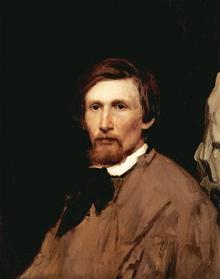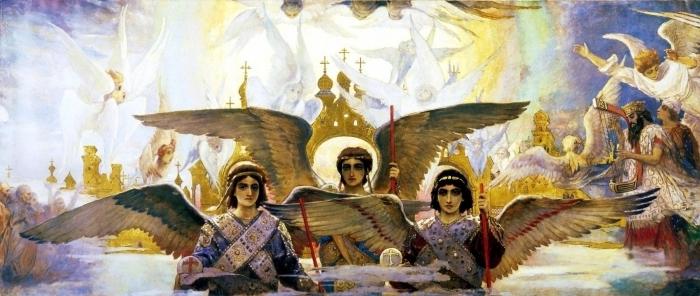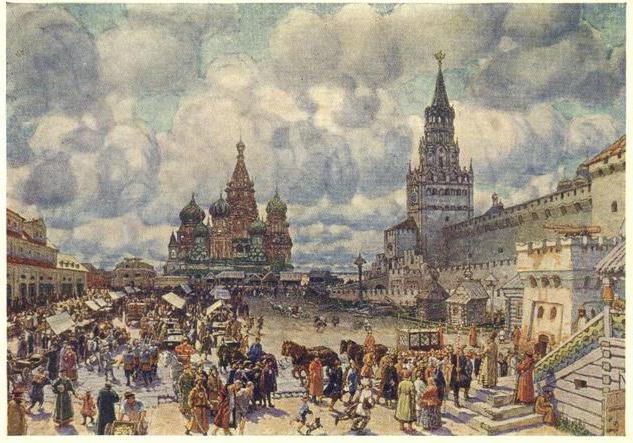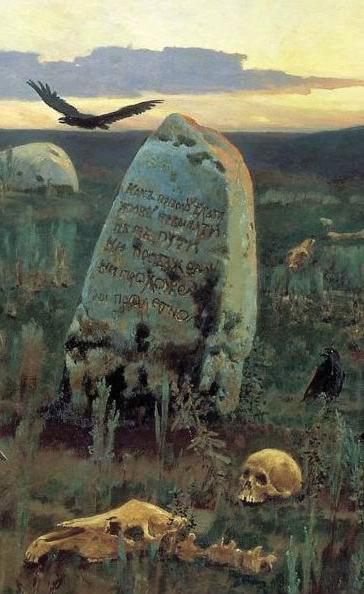Victor Vasnetsov (artist). The life and work of the most famous Russian artist of the XIX century
The great artist Viktor Vasnetsovwas born on May 15, 1848 in the village of Lopyal, in the family of Mikhail Vassilevich Vasnetsov, a priest. Father promised the future of the priest to his son, and in the early years of the young Vasnetsov, the young man obeyed his parents in everything and already followed in the footsteps of his father. However, a few years later his fate changed dramatically. Biography of the artist Vasnetsov contains pages of the formation and flowering of the talent of one of the most famous painters in the history of the Russian state.
He did not have students, as, for example, VI. Surikov or other famous artists, but the skill of Viktor Vasnetsov was open to imitation any beginning painter. And young artists tried to learn "vasnetsovskim" half-tones, present in his epic stories, or juicy merry paints, making the master's landscapes so vivid.

Seminary and Art
In 1858, at the insistence of his father, young Vasnetsov waswas assigned to a spiritual school, where he studied for four years, and then continued his studies at the Vyatka Theological Seminary. Then he opened the talent of the painter, and the future artist began to learn drawing from N. G. Chernyshov, the teacher of the gymnasium. Then, with the favor of his father, he left the seminary and moved to Petersburg, where he entered the School of Drawing and Development of Arts, to the class of Ivan Nikolaevich Kramskoy. After one year at school, Vasnetsov transferred to the Academy of Arts and continued painting there.
His student works the artist exhibited forgeneral review is still within the walls of the Academy, so that they will receive an assessment of recognized masters of the brush. Comments of venerable artists on the works of the beginning painter Vasnetsov were most benevolent, many critics noted the work of the young artist as a new word in art.
Association of the Wanderers
After graduating from the Academy of Fine Arts in 1873Vasnetsov the artist began to participate in the exhibitions of the Wanderers, organized in St. Petersburg and Moscow. The "Association" included twenty famous Russian artists, among which were: Kramskoy IN, Repin IE, Shishkin II, Polenov VD, Surikov VI and others. Viktor Vasnetsov was represented in mobile exhibitions by two paintings: "The Knight at the Crossroads" and "Alyonushka".

Bloom and sunset
The aim of the artists of the Wanderers was acquaintancebroad masses of the people with Russian art. The exhibitions were held everywhere, in cities and large villages, and the movement was developing and becoming stronger. The flourishing of the "Partnership" fell on 1870-1880. Later, the activities of the Wanderers began to fade for a number of objective reasons, and in 1922 their last exhibition was held.
Abramtzevo
Russian artist Vasnetsov was a member of Abramtsevskyartistic circle "organized by the industrialist and philanthropist Savva Mamontov, the owner of the Abramtsevo estate, arranged meetings of artists, sculptors, writers and musicians under the roof of the hospitable house of Savva Ivanovich, and later the circle turned into a major center of Russian culture. Painters came to Abramtsevo and lived for months there, creating his immortal canvases, Viktor Vasnetsov was also a frequent visitor, he was inspired by the untouched nature of the reserved surroundings, ancient Russian values, fields, forests and countryside e people as an integral part of landscapes.

Academy of Arts
In 1893 Vasnetsov the artist entered with the compositionAcademy of Arts and, already being an active member of the Academy, continued fruitful activities in the field of recreating Russian culture. Revolutionary movements in the early twentieth century also affected the great artist. Vasnetsov did not participate directly in the activities of the Union of the Russian People, a right-monarchist organization, but indirectly supported the Black-Hundred movement and even financed separate publications, such as the Books of Russian Sorrow. In 1912, the artist was introduced into the nobility of the Russian Empire. And in 1915 he became an active member of the Society for the Revival of Russia, which united many artists of that time.

Variety of creativity
Creativity of the artist Vasnetsov is differenta variety of styles, which can not be said about other Russian painters. He created paintings using opposite genres, sometimes incompatible with each other. Pictures of everyday nature with real characters were replaced by canvases with fairy-tale subjects. Still, the red thread throughout the artist's creative period is the epic historical theme. It was in this genre that Vasnetsov created his masterpieces: Bogatyri (1898), Tsar Ivan Vasilyevich Grozny (1897), Ivan Tsarevich on the Gray Wolf (1889), Alyonushka (1881) , "The Knight at the Crossroads" (1882), "After the Battle of Igor Svyatoslavovich with the Polovtsians" (1880).

Church subjects
In the run-up to the 20th century, Vasnetsov the artist,The "heroes" of which, written in 1998, became his calling card, refers to a religious theme. He writes paintings for the St. Vladimir Cathedral in Kiev and the Ascension Church in St. Petersburg, known as the Cathedral of the Savior on the Blood on the Griboedov Canal. Later, the artist took part in the painting of the interior of the Alexander Nevsky church, which is located in the capital of Bulgaria, Sofia. And for the Moscow church of Christmas on Presne Vasnetsov created sketches of ceiling and wall paintings.

Civil projects of the artist
Vasnetsov the artist in 1917 completelyswitched to the Russian folk epic, his pictures-fairy-tale "The battle of Dobryny Nikitich with the seven-headed Serpent Gorynych", written in 1918, and "Koshchei the Immortal" in 1926 were the last works of the great artist.
In addition to the brilliant paintings, Vasnetsov created a number of architectural and historical projects:
- In Abramtsevo manor the Church of the "Savior of the Holy Face" was built according to Vasnetsov's sketches together with the artist V.D. Polenov and the architect P.M. Samarin (1882)
- In Abramtsevo was built "Hut on chicken legs," a garden arbor on fairy motives (1883)
- The project of the grave monument of Yuri Nikolaevich Govorukha-Otroka, a Russian writer, in the necropolis of the Moscow Monastery of the Grieving (1896).
- Russian Pavilion for the World Exhibition of Paris in 1898.
- The project of I. Tsvetkov's mansion, together with the architect B.N. Schnaubert, in Moscow on the Prechistenskaya embankment.
- Draft layout of the main entrance of the Tretyakov Gallery, with the participation of architect V.N. Bashkirov in Moscow, Lavrushinsky Lane (1901).
- The project of the transition theater from the Armory Chamber to the Grand Kremlin Palace in Moscow (1901).
- Memorable cross, which distinguishes the place of the death of the PrinceGreat Sergey Aleksandrovich, in Moscow (1908), which was destroyed and subsequently restored by the sculptor N.V. Orlov, and then transferred to the Novospassky Monastery.
- Headstone Gringmut right-wing public figure, in Moscow, in the necropolis of the Skorybashchensky Monastery (1908).
- The Cathedral of St. Alexander Nevsky on the Miusskaya Square in Moscow, together with the architect A.N. Pomerantsev (1911).
- The project of an art postage stamp created to raise funds to help war victims (1914).

Philately
Vasnetsov the artist and his works were widely represented in the philately of the USSR:
- Postage stamp "Tretyakov Gallery" artist A.S. Pomansky was released in 1950. The stamp depicts the main facade of the Tretyakov Gallery, executed in 1906 according to the sketches of Viktor Vasnetsov.
- A series of postage stamps dedicated to the 25th anniversary of the death of artist Vasnetsov, painter I.I. Dubasov, 1951 year.
- Postage stamp with the image of V.M. Vasnetsov in the painting of the artist I. Kramskoy ", published in 1952 in ITC" Mark "under №1649.
- Postage stamp "Bogatyri" (according to Vasnetsov's painting from 1881-1898) ITC Marka №1650.
- Postage stamp "The Knight at the Crossroads" (1882), was issued in 1968, the design of artists A. Ryazantsev and G. Komlev, ITC "Mark", №3705.
- The 150th anniversary of Vasnetsov's birth was marked in Russia by the issue of a double postage stamp with a coupon.
For the entire creative life of the great artist, he wrote dozens of canvases. 24 paintings by Vasnetsov entered the Golden Fund of Russian Art:
- Year 1871 - "Gravedigger".
- Year 1876 - "From apartment to apartment".
- The year 1878 - "The Knight at the Crossroads".
- The year 1879 - "Preference".
- Year 1880 - "After the massacre of Igor Svyatoslavovich with the Polovtsians."
- The year 1880 - "Alenushkin pond."
- Year 1880 - "Carpet-plane".
- The year 1881 - "Alyonushka."
- Year 1881 - "Three princesses of the underworld".
- The year 1887 - "The Warriors of the Apocalypse."
- Year 1889 - "Ivan-Tsarevich on the Gray Wolf."
- Year 1890 - "The Baptism of Rus."
- Year 1897 - "Gamayun".
- Year 1897 - "Tsar Ivan Vasilyevich the Terrible".
- The year 1898 - "Heroes."
- Year 1899 - "The Guslar".
- The year 1899 - "Snow Maiden".
- Year 1899 - "Meeting Oleg with a magician."
- Year 1904 - "Last Judgment".
- The year 1914 - "Ilya Muromets".
- Year 1914 - "The Duel of Peresvet with Chelubey."
- Year 1918 - "The Frog Princess".
- Year 1918 - "Fight Dobryni Nikitich with the seven-headed Snake Gorynych."
- Year 1926 - "Koschey the Immortal". </ ul </ p>








